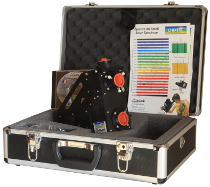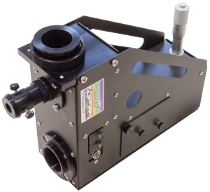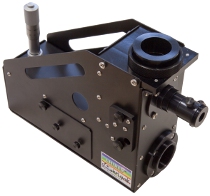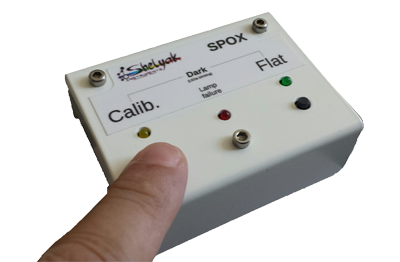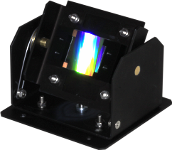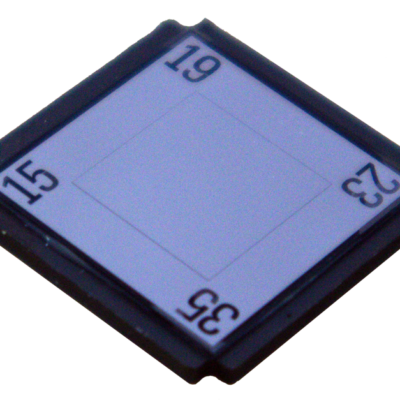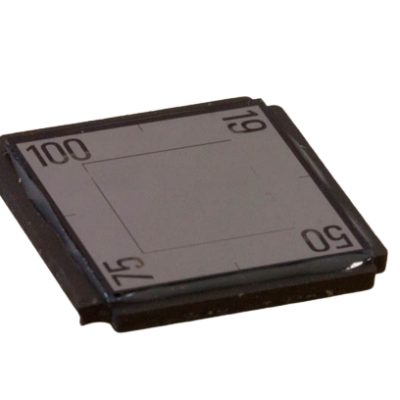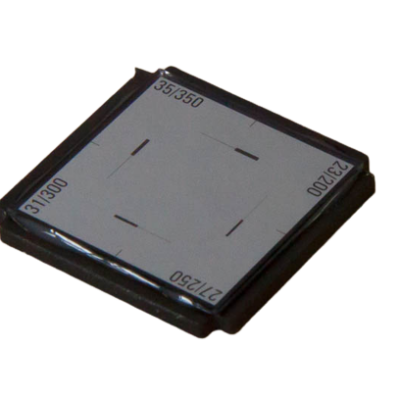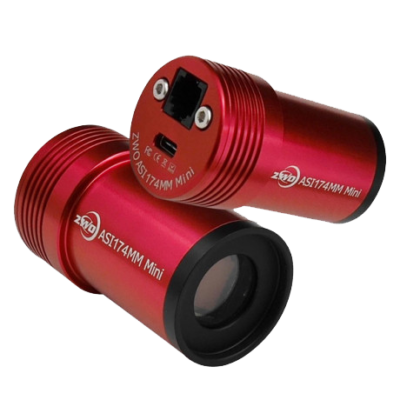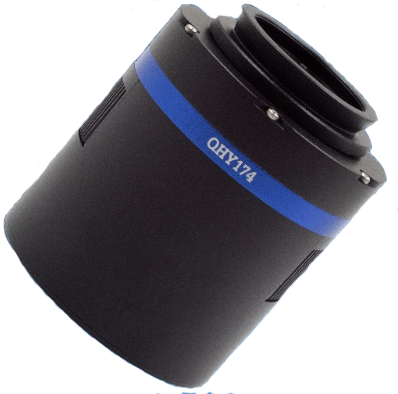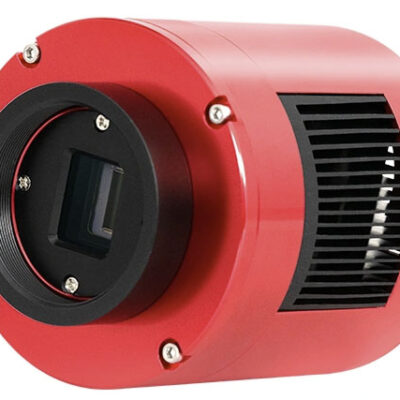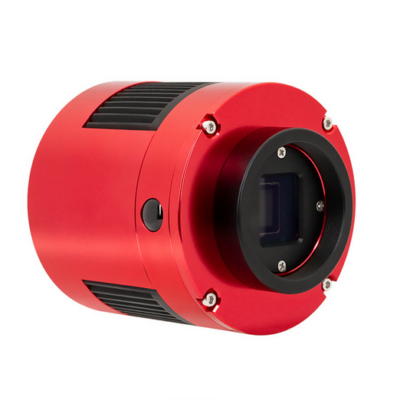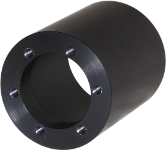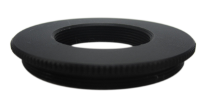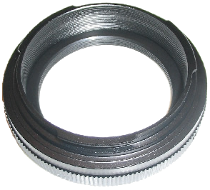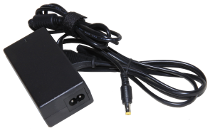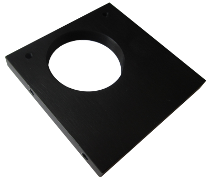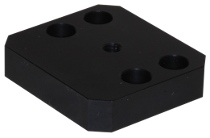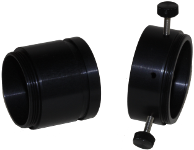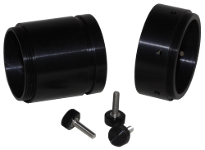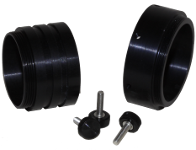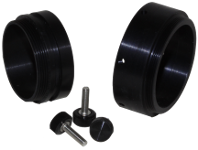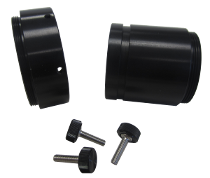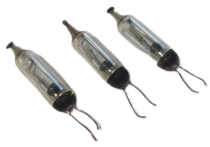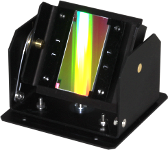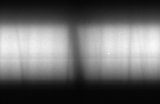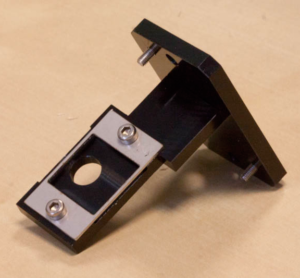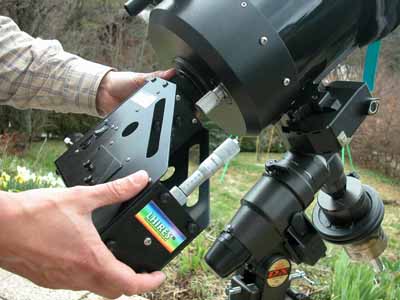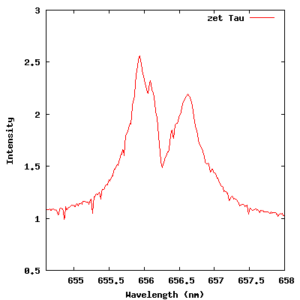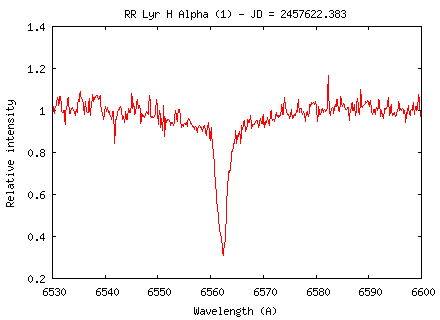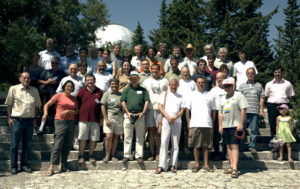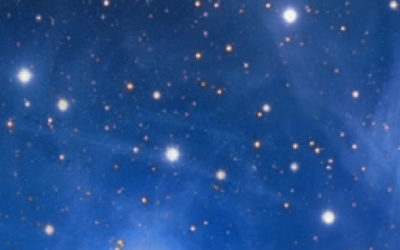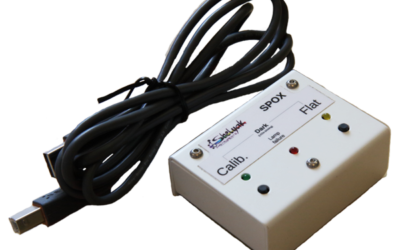On August 8, 2021, the recurrent nova RS Oph was observed in outburst at magnitude V = 5. The amateur community immediately mobilized to realize many spectra at various resolutions with various spectrographs (with resolving powers R = 600 to R = 30,000).
Lhires III Spectroscope
5 100,00 € incl. VAT - 4 250,00 € excl. VAT
The Lhires III spectroscope is the king of High Resolution (R = 18,000). Shelyak’s historic instrument was designed to observe details in one (or more) spectral lines. It’s the ideal tool for working with the Doppler effect and observing star activity.
Complete your Lhires III spectroscope with the products below
Additional modules
Additional modules: technical specifications
Description |
Shelyak ref. |
Acc. type |
Included |
Comment |
Integrated guiding module |
Guiding module |
|||
Integrated calibration module |
Calibration module |
|||
SPOX with 0.8m cable |
ES0013 |
Other add-on modules |
For remote control of flat and calibration lamps. Short cable for telescope installation. |
|
SPOX with 5m cable |
ES0012 |
Other add-on modules |
For remote control of flat and calibration lamps. Câble long pour une utilisation à côté du télescope. |
Grating module
Grating module : technical specifications
Description |
Shelyak ref. |
Included |
R @650 nm |
Dispersion (nm/mm) |
Blaze |
Grating module 2400 lines/mm for Lhires III |
SE0005 |
18000 |
1,3 |
VIS (holographic) |
|
Grating module 1800 lines/mm for Lhires III |
SE0121 |
11000 |
2,2 |
500 nm |
|
Grating module 1200 lines/mm for Lhires III |
SE0006 |
5900 |
3,9 |
500 nm |
|
Grating module 600 lines/mm for Lhires III |
SE0007 |
2800 |
8,2 |
500 nm |
|
Grating module 300 lines/mm for Lhires III |
SE0008 |
1400 |
16,6 |
500 nm |
|
Grating module 150 lines/mm for Lhires III |
SE0009 |
700 |
33,3
|
500 nm |
Slits
Slits : technical specifications
Description |
Shelyak ref. |
Included |
Material (% reflexion) |
Mirror size |
AR coating |
Comment |
Multiple slit 15/19/23/35 µm |
SE0116 |
Chromium (55%) |
17 x 17 mm |
400 – 700 nm |
Slits 15, 19, 23, 35μm |
|
Lhires III slit holder |
SE0192 |
Add for each additional slit |
||||
Photométric slit 23/27/31/35 µm |
SE0194 |
Chromium (55%) |
17 x 17 mm |
400 – 700 nm |
23/200, 27/250, 31/300, 35/350μm |
|
Wide slit 19/50/75/100 µm |
SE0122 |
Chromium (55%) |
17 x 17 mm |
400 – 700 nm |
Hole 19μm + slits 50, 75, 100 μm |
Recommended guiding cameras:
Recommended cameras: technical specifications
Description |
Shelyak ref. |
Included |
Acc. type |
Cooled
|
Comment |
Camera ASI174 mini |
EL0244 |
Guiding camera |
No |
Uncooled camera, sufficient for most applications. |
|
Caméra QHY174-MM Pro |
EL0253 |
Guiding camera |
yes |
Cooled camera, for long exposures (>30 seconds). Only useful for low-resolution, faint targets. |
Recommended acquisition cameras
Recommended cameras: technical specifications
Description |
Shelyak ref. |
Included |
Acc. type |
Cooled
|
Comment |
Caméra Atik 414 |
SE0176 |
Science camera |
Other accessories
Other accessories: technical specifications
Description |
Shelyak ref. |
Included |
Acc. type |
Comment |
12V/7A power supply + 4-way cable |
SE0133 |
Power supply |
12V power supply (7A), to power several accessories (cameras, lamps, etc.). Supplied with 5m silicone cable and 4 connectors (2x 2.5 mm and 2x 2.1 mm) |
|
Set of acquisition camera adapters: backfocus 13 mm |
SE0110 |
Rings |
For cameras with backfocus from 11 to 15 mm |
|
Set of acquisition camera rings: backfocus 23 mm |
SE0012 |
Rings |
For cameras with backfocus from 21 to 25 mm |
|
Set of acquisition camera adapters: backfocus 17 mm |
SE0014 |
Rings |
For cameras with backfocus from 15 to 19 mm |
|
Set of acquisition camera adapters: backfocus 25 mm |
SE0080 |
Rings |
For cameras with backfocus from 23 to 27 mm |
|
Set of acquisition camera adapters: backfocus 34 mm |
SE0082 |
Rings |
For cameras with backfocus from 32 to 36 mm |
|
2-inch adapter |
BA0001 |
Rings |
2″ nosepiece for Lhires III. Allows the Lhires III to be mounted on a telescope with a 2″ (50.8 mm) eyepiece holder. |
|
Spare Ar-Ne lamp |
SE0148 |
Spare lamps |
Spare calibration lamp (Argon & Neon). Requires the calibration module. |
All about the Lhires III spectroscope:
Description
An instrument of reference
The Lhires III spectroscope is Shelyak Instruments’ “historic” instrument. Designed from the CNRS Astrophysics School in 2003 for the observation of Be stars, it has since found a wide range of applications.
Resolution & spectral range
With a resolving power of R=18,000, it provides access to Doppler velocity measurements, as well as incredible detail in the profile of a line.
The network module supplied as standard has 2400 lines/mm, giving full resolution. It can be replaced by an optional module, to access other resolutions – making the Lhires III a versatile instrument. You can adapt your resolution to your project. Weaker objects are then accessible: Novae, bright comets…
The spectral range covered is limited (of the order of ten nanometers, due to the need for high resolution), but you can select any wavelength in the visible range (400-750nm), thanks to a micrometer.
Numerous educational projects based on the Doppler effect are now possible, such as the rotation of Jupiter or Saturn.
Example of a spectrum of Jupiter,
showing the planet’s rotation
(inclination of the solar lines).
Aperture
The F/10 aperture makes it particularly well suited to Schmidt-Cassegrain telescopes. But it can also be mounted on other, more open instruments (by adding a Barlow lens).
Guiding system
Thanks to its mirror slit, the Lhires III enables the target star to be precisely positioned and held in the slit. A guiding camera (not supplied) enables the telescope’s movements to be controlled (autoguiding), ensuring optimum observation.
Interchangeable slit
The interchangeable slit supplied as standard (15-19-23-35µm) means that the instrument can be adapted to most observations, giving priority to resolution or brightness if required. Other slits are also available as options (wide slits, photometric slits), to further extend the possibilities.
Mechanical interfaces
The Lhires III is supplied with a standard interface for Schmidt-Cassegrain telescopes. If you wish to adapt it to a 2″ eyepiece holder, use the optional 2″ adapter.
The CCD adaptor supplied as standard is suitable for ATIK cameras. (13mm mechanical backfocus). We offer a wide choice of adapter rings in our accessories catalog.
The guiding camera is C-mount.
Going further with Lhires III
In addition to the astrophysical knowledge it can provide, the Lhires III is also a tool for collaboration between amateur and professional astronomers: studying Be-type stars, tracking variable stars, etc. Numerous scientific papers have been based on observations with a Lhires III.
The support of a large community
The Lhires III is widely used around the world, and you can find many examples of use and advice on the Spectro-L discussion list: https://groups.io/g/spectro-l or on the spectroscopy forum: ARAS.
Specifications
- Resolution power R ~18000 (with 23 µm slit)
- Dispersion of 0.012nm (9µm pixels, around Hα)
- Aperture F/10
- Littrow architecture (the same achromatic doublet serves as collimator and lens)
- Adaptor rings for different types of detectors: CCD cameras, Digital Cameras, etc.
- Mirror slit for precise guiding (4 positions 15/19/23/35 µm).
- Slit length 8 mm
- Wavelength selected per micrometre throughout the visible range (400-700 nm)
- Included wavelength calibration lamp (argon/neon)
- Included tungsten lamp for flats
- Motorised calibration lamps for remote use
- Schmidt-Cassegrain adaptor (2″) as standard, mechanical backfocus 68.5 mm,
- Dual-lens C-mount guide port (focal ratio: 0.8x), mechanical backfocus 17.5 mm guide camera
- T-mount acquisition port, mechanical backfocus 55 mm (APN compatible)
- Interchangeable grating module (2400 tt/mm as standard)
- Light: 1.7 kg
- Compact: 250 mm x 200 mm x 83 mm
- Supplied in a hard case, with an eyepiece holder and a set of tools.
Composition
- The Lhires III spectroscope
- The interchangeable slit (15-19-23-35µm)
- Schmidt-Cassegrain telescope interface
- CCD adapter (for camera with 13mm back focus)
- Eyepiece holder (for observing the Sun’s spectrum by eye; eyepiece not supplied)
Documents
- The User Guide contains:
→ Setting the Lhires III
→ Your first steps in spectroscopy
→ Reminders of theory
→ Some projects
Note: this document corresponds to the first version of Lhires III. Some parts are obsolete. - A video tutorial on how to set up your LHIRES III
- A few Questions & Answers about Lhires III
- Lhires III+ update manual (argon-neon calibration module and motorised flat, guide mirror modification, new 0.8x guide port)
Note: this update is now integrated in all Lhires III - Argon-Neon spectrum with commentary (Manfred Schwarz): http://www.astrophoto.at/spectrum/Reference/ArNe.htm
- ISIS tutorial (for data reduction): http://www.astrosurf.com/buil/isis/guide_lhires/tuto1.htm
- Assembly instructions: for the AUDE project, the Lhires III was supplied as a DIY kit. The assembly instructions can help you understand the inner workings of the spectroscope.
- Set of drawings to help you integrate the Lhries III with your equipment.
- A STEP file giving the external volume of the Lhires III for integration in your telescope project, for example.
- Solar spectrum with comments, made by Olivier Garde with his Lhires III.
- Low-resolution solar spectrum
- You can also find more technical and practical information on the following websites:
→ http://www.astrosurf.org/buil/lhires3/project.htm - Tuning your LHIRES III : online workshop
Applications
- High-resolution spectrum of variable stars
- Time series of the pulsating star (RR Lyr)
- High-resolution solar spectrum
- Radial velocities of stars Vr
- Star rotation: v.sin(i)
- Spectroscopic binaries
- Rotation of planets (Jupiter, Saturn)
- and so on…
Articles related to the Lhires III spectroscope:
Study of a spectroscopic binary with amateur setup
In this article, I will try to show you that amateur astronomers can achieve remarkable results in the astrophysical study of the stellar world.
Nearby or in thousands of km, take control of your calibration & flat lamps for Alpy, Lhires III and LISA.
SPOX module : to remotely control the flat and calibration lamps for Alpy 600, Lhires III and LISA.
